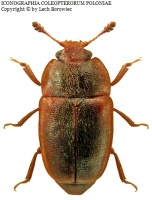Підтримуємо Вільну Україну
 We Support Free Ukraine
We Support Free Ukraine

Biodiversity Map
Taxa

-
Arthropodaphylum
Click to switch
to select orders
and filters > -
Hexapodasubphylum
Click to switch
to select orders
and filters > -
Insectaclass
Click to switch
to select orders
and filters > -
Coleopteraorder
Click to set
as the main taxon
and as a base
← of the left panel > -
Polyphagasuborder
Click to set
as the main taxon
and as a base
← of the left panel > -
Cucujiformiaseries
Click to set
as the main taxon
and as a base
← of the left panel > -
Cucujoideasuperfamily
Click to set
as the main taxon
and as a base
← of the left panel > -
Nitidulidaefamily
Click to set
as the main taxon
and as a base
← of the left panel > -
Epuraeinaesubfamily
Click to set
as the main taxon
and as a base
← of the left panel > -
Epuraeagenus
Click to set
as the main taxon
and as a base
← of the left panel > -
Epuraeanellasubgenus
Click to set
as the main taxon
and as a base
← of the left panel >
species:
Epuraea (Epuraeanella) neglecta
PL
YES
name status: valid name
BioMap ID: 1017791
taxon code: 3291
taxonomy checked: YES
Data on distribution in Poland

Statistics
- Records: 173
- Publications: 49
- Collections: 14
- Publication authors: 53
- Illustrations (iconography): 1
- Photos (specimen/observation): lacking
Taxon description
Gatunek europejsko-syberyjski, w Europie rozmieszczony od południowych prowincji Fennoskandii oraz Karelii aż do Pirenejów, północnych części Włoch i Półwyspu Bałkańskiego; notowany też z Kaukazu. W Polsce, choć nie znany jeszcze ze wszystkich krain, występuje prawdopodobnie na całym obszarze. Zasiedla zarówno tereny nizinne, jak i górzyste. Łowiony od maja do października na różnych roślinach wzdłuż pobrzeży lasu i dróg leśnych, pod wilgotną korą drzew liściastych (zwłaszcza brzóz, buków, dębów), w soku płynącym z ran tych drzew, oraz na hubach i pod wilgotną ściółką bukową.
Illustrations
... browse
 Epuraea
Epuraeaneglecta
External data sources
- Ostatnie rekordy
-
1091288
 ×
× Nitidulidae: Epuraea neglecta, CZ, Beskid, leg. Graf
Nitidulidae: Epuraea neglecta, CZ, Beskid, leg. Graf -
774753
 ⊡
⊡ Nitidulidae: Epuraea neglecta, PL, Dolny Śląsk, Muszkowice, UTM XS31, 1990, leg. L. Borowiec, coll. Uniw. Wrocławski, ZBiTE
Nitidulidae: Epuraea neglecta, PL, Dolny Śląsk, Muszkowice, UTM XS31, 1990, leg. L. Borowiec, coll. Uniw. Wrocławski, ZBiTE -
774752
 ○
○ Nitidulidae: Epuraea neglecta, PL, Puszcza Białowieska, Białowieski P.N., UTM FD94, 1991, leg. L. Borowiec, coll. Uniw. Wrocławski, ZBiTE
Nitidulidae: Epuraea neglecta, PL, Puszcza Białowieska, Białowieski P.N., UTM FD94, 1991, leg. L. Borowiec, coll. Uniw. Wrocławski, ZBiTE -
737498
 ×
× Nitidulidae: Epuraea neglecta, PL (Lasoń 2004a)
Nitidulidae: Epuraea neglecta, PL (Lasoń 2004a) -
719126
 ×
× Nitidulidae: Epuraea neglecta, PL, 1911, coll. IOR
Nitidulidae: Epuraea neglecta, PL, 1911, coll. IOR -
687447
 ×
× Nitidulidae: Epuraea neglecta, PL, Puszcza Białowieska, Białowieża ad nadl. Białowieża, 2004, leg. A. Rutkiewicz (Byk et al. 2006)
Nitidulidae: Epuraea neglecta, PL, Puszcza Białowieska, Białowieża ad nadl. Białowieża, 2004, leg. A. Rutkiewicz (Byk et al. 2006) -
687445
 ×
× Nitidulidae: Epuraea neglecta, PL, Puszcza Białowieska, Białowieża ad nadl. Białowieża, 2004, leg. A. Rutkiewicz (Byk et al. 2006)
Nitidulidae: Epuraea neglecta, PL, Puszcza Białowieska, Białowieża ad nadl. Białowieża, 2004, leg. A. Rutkiewicz (Byk et al. 2006) -
687444
 ×
× Nitidulidae: Epuraea neglecta, PL, Puszcza Białowieska, Białowieża ad nadl. Białowieża, 2004, leg. A. Rutkiewicz (Byk et al. 2006)
Nitidulidae: Epuraea neglecta, PL, Puszcza Białowieska, Białowieża ad nadl. Białowieża, 2004, leg. A. Rutkiewicz (Byk et al. 2006) -
687443
 ×
× Nitidulidae: Epuraea neglecta, PL, Puszcza Białowieska, Białowieża ad nadl. Białowieża, 2004, leg. A. Rutkiewicz (Byk et al. 2006)
Nitidulidae: Epuraea neglecta, PL, Puszcza Białowieska, Białowieża ad nadl. Białowieża, 2004, leg. A. Rutkiewicz (Byk et al. 2006) -
686406
 ×
× Nitidulidae: Epuraea neglecta, PL, Puszcza Białowieska, Białowieża ad nadl. Białowieża, 2004, leg. A. Rutkiewicz (Byk et al. 2006)
Nitidulidae: Epuraea neglecta, PL, Puszcza Białowieska, Białowieża ad nadl. Białowieża, 2004, leg. A. Rutkiewicz (Byk et al. 2006) - ... more
- Powiązane publikacje
-
Lasoń A., Marczak D., Kubisz D., Tykarski P. 2011. Kateretidae and Nitidulidae (Coleoptera) of the Mazovian Lowland. Pol. Pismo Ent., 80(2):299-320.
 full text
full text Show records
Show records -
Gutowski J.M., Kubisz D., Sućko K., Zub K. 2010b. Sukcesja saproksylicznych chrząszczy (Coleoptera) na powierzchniach pohuraganowych w drzewostanach sosnowych Puszczy Piskiej. Leś. Pr. Bad., 71:279-298.
 Show records
Show records -
Ivinskis , Merzijevskis , Rimsaite 2009. Data on new and rare for the Lithuanian fauna species of Coleoptera. Naujos ir retos Lietuvos vabzdžių rūšys, 21:45-63.
 Show records
Show records -
Mokrzycki T. 2007. Waloryzacja ekosystemów leśnych Gór Świętokrzyskich na podstawie struktury zgrupowań chrząszczy związanych z pniakami. [In:] Borowski J., Mazur S. (Eds.) Waloryzacja ekosystemów leśnych Gór Świętokrzyskich metodą zooindykacyjną. Wydawnictwo SGGW, Warszawa. pp. 148-193.
 Show records
Show records -
Byk A., Mokrzycki T., Perliński S., Rutkiewicz A. 2006. Saproxylic beetles – in the monitoring of anthropogenic transformations of Białowieża Primeval Forest. [In:] Szujecki A. (Ed.) Zooindication-based monitoring of anthropogenic transformations in Białowieża Primeval Forest. Warsaw Agricultural University Press, Warsaw. pp. 325-397.
 Show records
Show records - ... more




